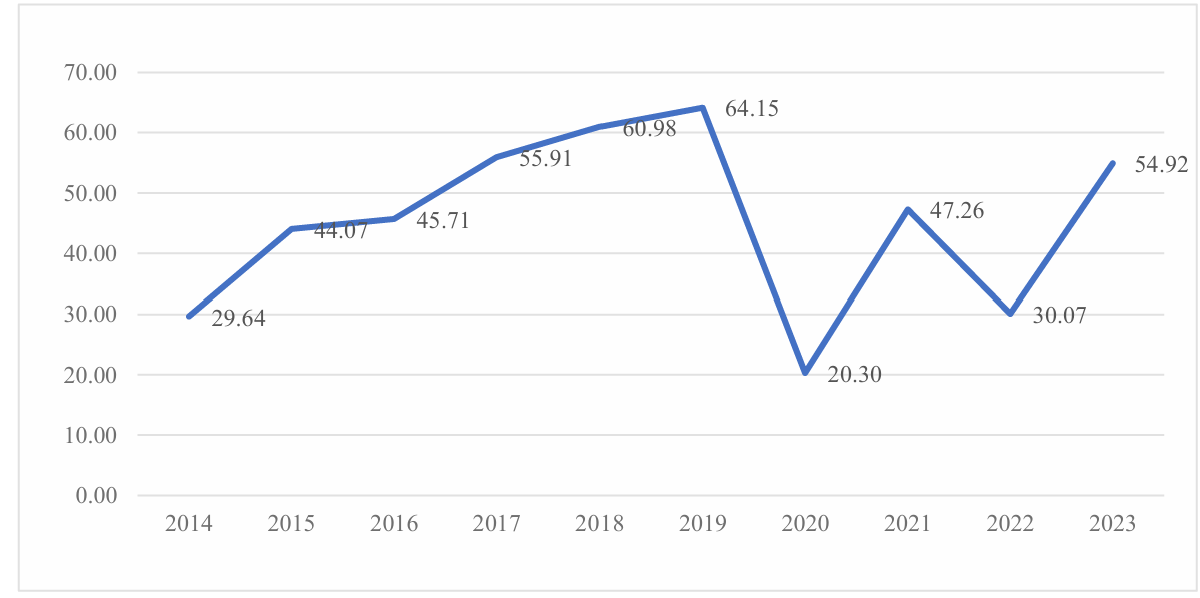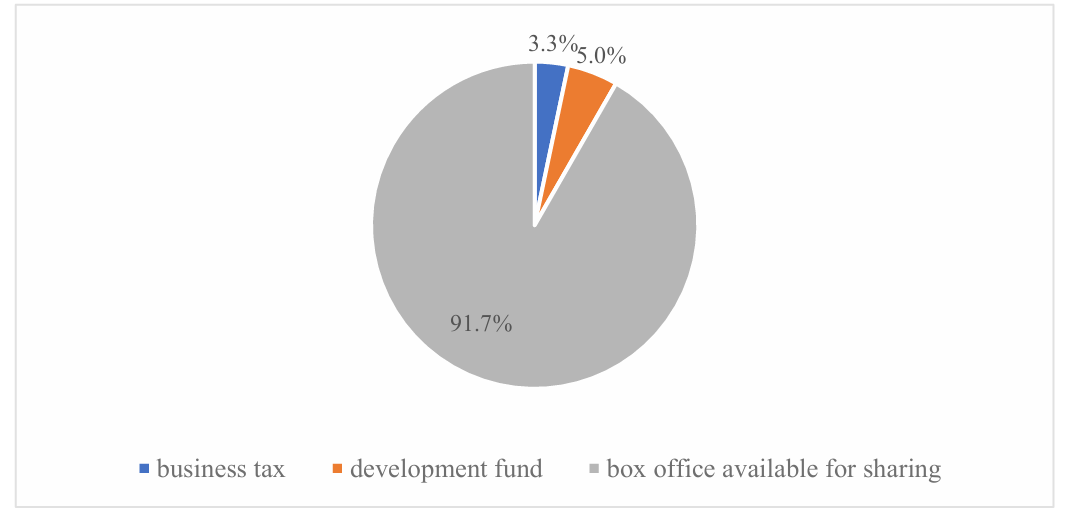1.Introduction
In recent years, pop culture has been impacted by the background of a globalized community. Additionally, the film and television industry as a subfield of pop culture has emerged as an essential force in developing the global economy. For instance, attributed to the COVID-19 pandemic, streaming services in the film and television industry have become more prevalent with modified ways of film production and distribution [1, 2] Although there were a lot of challenges, the Chinese film industry has shown resilience with quality production [2]. In 2023, China's overall box office reached 54.915 billion RMB, and domestic development-produced films played an essential role, incorporating 83.8% of the annual box office, showing the trend of domestic development in the film and television industry [3]. Therefore, due to the significant impact of the film and television industry in China, even during emergencies, researching and exploring the structure and details of the industry is worthwhile for further development and increment in the Chinese economy. Additionally, the paper is meant to delve into intricate ways the film and television industry affects national income within the Chinese region.
By analyzing elements that affect national income in China, the report would evaluate the contribution that this industry provides to China, which would manifest the industry’s tenacity and potential. Furthermore, the report is utilized to assist investors in the film and television industry and support the government to make adequate policies for adjusting and developing not only the industry but also China as a whole. The significance is that culture within the countries could be shown through diverse media since studies have already explored the influences of social media on cultural identity, and statistics have proved that media platforms can influence and reflect cultural values and identities [4]. As a result, the report will help to spread Chinese culture, which would attract domestic or foreign workers to produce related derivatives and bring out product promotion.
2.Literature Review
Previous studies have examined some substantial impacts of the film and television sector, and the studies can be utilized to elevate the production of the film and television series to boost economic growth. One reason for the increment in the economy is the digital prospect that appears worldwide. Some researchers believe that digital platforms are gaining more and more focus and utilization; consequently, through the trends of digital media, the economies of countries will be enhanced monumentally. As an illustration, Chalaby emphasizes the significance of the internationalization of the production process by specifically focusing on China’s burgeoning market in 2016, which mentions the effects of digital platforms during the spreading process [5]. The study by Polyxeni and Eli Hustad depicts the differences in using digital resources and disparities when assessing diverse media. The authors attempt to connect the influences of digital sources to the achievement of sustainable societies. While reviewing the factors attributed to the digital divide, the study concludes that with the increasing utilization of digital platforms and addressing the digital divide situation, economies can experience significant growth [6]. Moreover, the study examines the relationship between economic growth efficiency and the impact of urban digital transformation by researching the effects of digital industrialization on economic growth with double fixed-effects and spatial Durbin models. The study emphasizes, eventually, that digital media is a key element for boosting economic growth and efficiency in cities, and it is important to implement regional collaboration and integrated strategies into the development of the digital economy [7].
Some of the other researchers believe that the film and television industry could enhance the economy by providing more occupations and chances of employment. Thorsten Hennig-Thurau, S. Abraham Ravid, and Olav Sorenson’s studies, the research objects of the globalized film and television industry, including film, television, animation, and digital games, have intricate commercial structures and ways of operations. These structures have offered places for many employers and a lot of profits because film and television professionals could show their capacities for providing services, skills, and film products to local and global audiences [1]. The studies from Mario Torre focus on the investments in television, cinema, and web-based productions to examine the economic aspects of the audiovisual industry and detail the challenges faced by the industry due to reduced public funding and the industry's historical distance from capital markets. It provides an in-depth analysis of financing mechanisms, including the adaptation of traditional assessment methods to account for exploitation rights, distribution deals, and risk factors. In conclusion, the paper claims the approach of the pricing model for audiovisuals promotes a sustainable and profitable relationship between the industry and financial markets, leading to more occupations, decrement in unemployment, and economic growth [8]. Furthermore, Daniel Ashton researches the usage of the "runner" as an elementary-level position in the UK film and television production industry and how it contributes to the sector. By analyzing the characteristics of being a “runner”, the paper reveals that the industry promotes the runner role as a necessary step for career progression. Hence, the findings engage with the evolving expectations and qualifications of new entrants, which highlight the industry's potential to offer varied occupational opportunities and employment chances [9]. The following paper will mainly focus on statistics manifestation and analysis of the employers of the Film and Television Industry. The paper would eventually connect the employer’s salaries and the exact origin of the salaries in the film and television industry with China’s National Income.
3.Methodology
3.1.Current Status of Film and Television Industry
Over the past years, the Chinese film and television industry has undergone monumental modifications. The pandemic appeared during the period as a presentation and determinator of the industry’s condition and resilience. By giving out the statistics for the workers’ income in the film and television industry and sorting the workers according to the scale they work for, the industry's development trends would be manifested. The practitioners and workers in the film and television industry mainly include film and television makers, such as directors, producers, and scriptwriters. For further illustration, renowned directors like Jiawei Wang, Yimou Zhang, and Hao Ning significantly contribute to China’s film and television industry by producing films that are prevalent and influence filmmakers worldwide, as well as spreading China’s traditional culture and aesthetics. Technology suppliers, incorporating editors of visual and sound effects, are necessities in filmmaking procedures. They elevate the qualities of films or TV series, increasing the willingness of people to see the films or television series, and boost an important component of the film and television industry, who are investors, to provide financial aid for the filmmaking process. Moreover, film and television promotion happens in streaming media platforms, film festivals, and film and television markets. In fact, at film festivals, not only new films of diverse genres would be presented, but also many prizes are announced, and it is a platform for filmmakers to communicate and interact with audiences.
Last but not least, film and television companies allocate financial resources, release screenings, and administrate copyrights, legal affairs, filmmaking, and personnel to ensure the quality of the films or television series. Eventually, audiences act as essential participators in the film and television industry, since their feedback and choices of film-watching directly affect the demand and future trends of movies and television series [10]. According to the reflections of consumers, the government will make related policies and administration that have a profound impact on the development of the film and television industry.
Including all the workers mentioned in the film and television industry, China’s industry chain is well-organized and delicately constructed. Firstly, in the upstream of the industry, investors usually have an overview of the scripts or short spoilers to decide whether they would invest and how much they invest in the creation of programs. With the input of money, the film or television program would be able to take action for shooting and making visuals and sound effects. Then, film or television corporations will supervise the content and publication procedure, and ensure all the copyright payments are paid with all the rights served. In the middle stream of the industry, the publicity of the movies and television series is spread out to the public from corporate Issuers, for instance, Universal Studios, and network publishers. Tao Piaopiao Movie & TV Culture, iQIYI, and Maoyan Entertainment as illustrated as the most prevalent network publishers help more people to notice the out-coming television series or movies. Furthermore, In the downstream of the industry, these companies sell tickets to the consumers. The online platforms bring plenty of convenience for consumers to check whether the seats and tickets they desire are available, and they can purchase the tickets whenever they want before the platforms cease to sell. In addition, under government regulation, legal derivatives, such as audio-visual products, related books, and toys, which are an extension of the film and television industry chain will be produced for marketing. Usually, the derivatives present unique characteristics that align with the content of the movies or television series, which also manifest the traditional culture of diverse countries [10].
The scale of China’s film and television industry is one of the largest in the world due to the enhancement of techniques for making film and television series, Chinese film and television consumers’ increasing desire for high-quantity movies and TV series, and the government support in the industry [11]. When determining the scale of the film and television industry, total box office revenue manifests the development trend and plays a crucial indicator for the film and television industry. As shown in Figure 1, the total box office revenue from 2014 to 2019 goes through increasing trends as the value inclines from approximately 29.64 billion yuan in 2014 to approximately 64.15 billion yuan in 2019, which shows the climax of total box revenue during 6 years. The trend manifests the increasing favor and willingness for people to buy tickets and watch movies in the cinemas. In the year 2020, the Chinese film and television industry is greatly impacted by the COVID-19 pandemic, causing the annual box office revenue to drop drastically to about 20.30 billion yuan. However, the recovery of the industry in China is still distinct. Accompanied by government intervention and the resilience of the film and television industry, the total box office continues to increase with fluctuations. In 2023, the total box office revenue increased by 82.6% from the year 2023, and in the first half year of 2024, the recovery rate reached 76%. The statistics show the large scale of the Chinese film and television industry and the comparatively good recovery rate and total office box value during the past ten years, which suggests the excellent ongoing procedures and future development and potential of the industry.

Figure 1: Annual total box office revenue in China (billion yuan) (Picture credit: Original).
3.2.The Impact of Income Structure on the Increment of National Income
Just like the organized industry chain, the Chinese film and television industry also has a thorough income distribution process. Initially, the total box office revenue is required to pay 3.3 percent of business tax and a film industry development fund of 5 percent, which is an addition of 8.3 percent of the total box office revenue as summarized in Figure 2 [12]. Additionally, since the business tax directly goes to the government, the better the film and industry in China developments, the more tax the government obtains. As it is known to all, the government transfer payments, including unemployment benefits, retirement pensions, and poverty grants, are counted in the calculation of national savings in China. As a result, enhancing the development of the film and television industry in China would increase national savings in China by enriching the government and providing more transfer payments for citizens. The government could supervise the taxing process to ensure every tax is strictly paid to maintain the amount of national income. Moreover, a percentage of the development fund is paid to the "Special Fund Office", which will later be put into the national treasury for future utilization of Chinese film and industry development.

Figure 2: Box Office Revenue (%) (Picture credit: Original).
In Section 3.1, all kinds of workers in the film and television industry are illustrated. Even though the practitioners and the industry chain are well organized in China, there are many workers in the process, including workers from the upstream, middle stream, and downstream. Due to the structure of the film and television industry, many job opportunities are provided to the citizens in China, increasing the value of national income. Moreover, the unemployment problems that caused the fall in the national income can be solved. Take some examples of the workers as an illustration. There are many background actors in films and TV series, and these actors usually do not require high acting skills to get the occupations. Some other jobs in the industry, such as ticket inspectors, do not require a lot of skills to take the jobs. Hence, a certain amount of structural unemployment would be eliminated, so national income in China would increase.
In addition, the impact of the film and television industry on national income is not merely restricted to the industry itself. Inter-industry effects are attributed to the reason that the spread and development of the film and television industry will boost the educational field of this area. With more notices on the basic education of film and television, more students will focus on this area, which could employ more teachers to teach the courses related to films and television and enlarge the scale of the industry in China. Both deductions will lead to the incline of national income. The government can publicize more public service advertising to enable more people to have interests in the field of films and television. Furthermore, media such as film and television series are a perfect way to spread Chinese traditional culture. Through media platforms, more people will learn about Chinese culture and Chinese people will have national self-confidence. Most importantly, the sales of derivatives of Chinese traditional culture derived from films and television series will add up to national income in China, increasing the satisfaction of living of Chinese citizens.
4.Limitation and Outlook
This paper mainly focuses on statistics from the year 2014 to 2023 and the first half year of 2014. As a result, in the future, different discoveries might appear with more information to analyze the trends and some more specific circumstances as a basis, such as natural disasters, financial fluctuations, and technological advancement. Due to the modification of situations, new development trends might be shown or strengthened.
In addition, the paper only listed several methods to present how the film and television industry is related to the national income in China. Future researchers who are interested in the topics can do more in some other ways to show the relationship between national income and the industry. For instance, future papers may add more quantitative methods, such as illustrating more examples related to current international affairs, and more case studies to prove the argument would enable the reasoning to become more thorough.
5.Conclusion
The film and television industry in China has experienced transformation and growth in the past ten years. The pandemic acts as an indicator for the Chinese film and television industry. According to the statistics of China’s total office box revenue from 2014 to the first half year of 2024, the vast scale and remarkable recovery rate after the COVID-19 pandemic prove the robust future and the efficiency for further development of the industry. Concerning the indicator of national income for determining the development level of the world, the industry's financial contributions, including taxes and a development fund, have significantly augmented national savings and supported government initiatives. Moreover, job creation could indirectly boost the national income of the industry, stimulating educational and cultural sectors. With the sales of cultural derivatives further contributing to the national income, living standards and satisfaction of Chinese citizens will be enhanced. Additionally, the government's role in fostering the industry is crucial for maintaining national income and promoting cultural identity through film and television. The government could make more supervision on the business tax and developmental funds to ensure everyone hands in the taxes while the government and companies should provide more sources of job-hiring to people who are unemployed as the film and television industry have a lot of chances of employment for these people. What’s more the government and corporates should pay more focuses on derivatives, which manifests Chinese culture from films and Television series. In this way, the Chinese film and television industry's development is not only an incline in one area just as a cultural triumph but also acts like an economic boon, showing the overall economic growth in China as the national income increases significantly.



